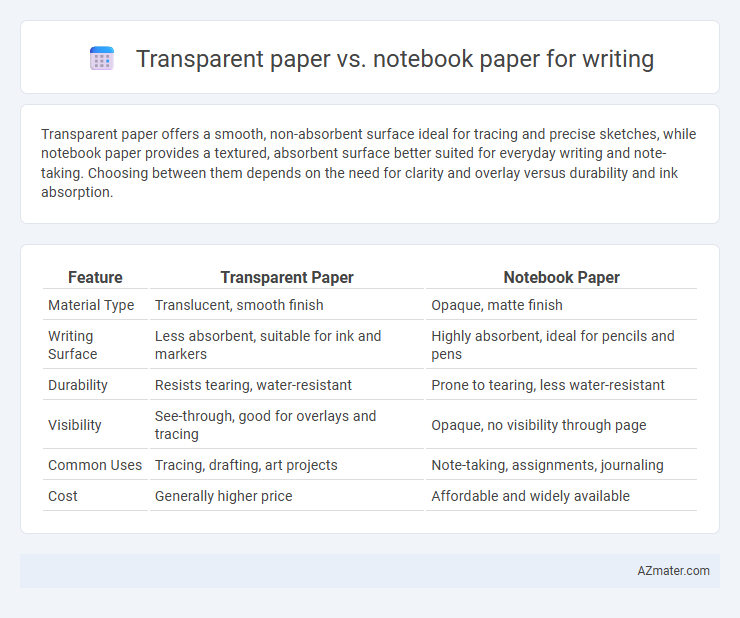Transparent paper offers a smooth, non-absorbent surface ideal for tracing and precise sketches, while notebook paper provides a textured, absorbent surface better suited for everyday writing and note-taking. Choosing between them depends on the need for clarity and overlay versus durability and ink absorption.
Table of Comparison
| Feature | Transparent Paper | Notebook Paper |
|---|---|---|
| Material Type | Translucent, smooth finish | Opaque, matte finish |
| Writing Surface | Less absorbent, suitable for ink and markers | Highly absorbent, ideal for pencils and pens |
| Durability | Resists tearing, water-resistant | Prone to tearing, less water-resistant |
| Visibility | See-through, good for overlays and tracing | Opaque, no visibility through page |
| Common Uses | Tracing, drafting, art projects | Note-taking, assignments, journaling |
| Cost | Generally higher price | Affordable and widely available |
Introduction: Transparent Paper vs Notebook Paper
Transparent paper, often known as tracing paper, offers a smooth surface ideal for precise drafting, sketching, and layering text or images. Notebook paper, designed primarily for daily writing and note-taking, features ruled lines to maintain consistent handwriting and is more absorbent for pens and pencils. Choosing between transparent paper and notebook paper depends on whether clarity and layering or structured writing is the primary need.
Material Composition and Manufacturing Differences
Transparent paper is primarily made from cellulose fibers treated with chemicals to enhance translucency, using processes like calendering and coating to create a smooth, glossy surface ideal for tracing or overlays. Notebook paper, typically composed of wood pulp with added fillers and sizing agents, undergoes a standard pulping and drying process to achieve an opaque, matte finish suited for writing with ink or pencil. The manufacturing differences result in transparent paper having higher fiber density and less opacity, while notebook paper emphasizes rigidity and ink absorption for everyday writing tasks.
Writing Experience: Smoothness and Ink Absorption
Transparent paper offers a unique writing experience with a smooth surface that reduces friction, allowing for fluid pen movement and precise ink application. In contrast, notebook paper typically has a more textured finish that may cause slight resistance, affecting writing speed and comfort. Ink absorption on transparent paper is lower, leading to slower drying times and potential smudging, whereas notebook paper absorbs ink more efficiently, promoting quick drying and less bleed-through.
Transparency and Its Impact on Legibility
Transparent paper offers a unique characteristic of translucency that can influence writing legibility by allowing underlying text or images to show through, potentially causing visual distractions. Notebook paper, typically opaque with a matte finish, ensures clearer contrast between ink and surface, enhancing readability and minimizing eye strain during prolonged writing. The level of transparency in paper directly affects the sharpness and clarity of handwritten content, making notebook paper generally preferable for legibility-focused applications.
Durability and Resistance to Wear
Transparent paper offers moderate durability but is more prone to tearing and creasing compared to notebook paper, which is specifically designed for repeated handling and writing. Notebook paper features higher resistance to wear, with sturdier fibers that withstand erasing and frequent page turning without significant damage. For long-term use and frequent writing sessions, notebook paper provides superior durability and resistance to wear compared to transparent paper.
Suitability for Different Writing Instruments
Transparent paper's smooth surface is ideal for fine-tipped pens, markers, and technical drawing instruments, offering minimal ink bleed and precise line work. Notebook paper, often textured and more absorbent, works well with ballpoint pens, pencils, and gel pens, preventing smudging while providing good grip for handwriting. Choosing between transparent paper and notebook paper depends on the writing instrument's ink flow and precision requirements.
Artistic and Creative Applications
Transparent paper offers unique advantages for artistic and creative writing applications, allowing artists to overlay sketches and text seamlessly while experimenting with layering effects and mixed media techniques. Notebook paper provides a traditional surface suited for straightforward note-taking and drafting but lacks the translucency required for tracing, design iteration, and visual brainstorming. Creative professionals often prefer transparent paper for its flexibility in refining ideas through repeated overlays, enhancing precision and depth in visual storytelling and calligraphy projects.
Cost and Accessibility Comparison
Transparent paper tends to be more expensive and less accessible than standard notebook paper, making it a less common choice for everyday writing tasks. Notebook paper is widely available in various formats and price points, often sold in bulk for cost efficiency, which suits budget-conscious users. Cost-effectiveness and easy access to notebook paper contribute to its popularity for writing compared to the specialty nature of transparent paper.
Environmental Impact and Sustainability
Transparent paper, often made from cellulose fibers or synthetic materials, offers durability and water resistance but typically involves higher energy consumption and chemical use during production, impacting its environmental footprint. Notebook paper, usually sourced from wood pulp, can be more sustainable when certified by organizations like FSC or produced using recycled content, reducing deforestation and landfill waste. Choosing notebook paper with eco-certifications supports sustainable forestry practices and decreases overall environmental impact in writing materials.
Choosing the Best Option for Your Needs
Transparent paper offers a smooth surface ideal for tracing, sketching, and layering creative work, while notebook paper is designed for everyday writing with ruled lines that promote neatness and organization. Selecting the best option depends on your writing purpose: transparent paper suits artistic and design tasks requiring precision, whereas notebook paper is more practical for note-taking, journaling, and academic use. Consider factors like paper texture, durability, and compatibility with your preferred writing instruments to match your specific needs effectively.

Infographic: Transparent paper vs Notebook paper for Writing
 azmater.com
azmater.com